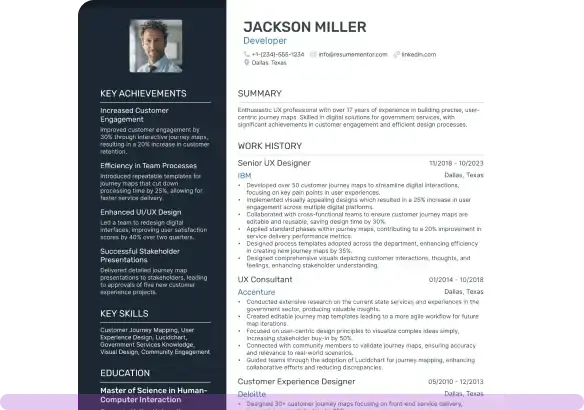Nonprofit Resume Examples

Mar 31, 2025
|
12 min read
The nonprofit sector seeks compassionate candidates like you. Get noticed with a heart-filled resume that makes you the "write" choice! This guide helps you highlight your skills, experience, and passion for making a difference.
Rated by 348 people
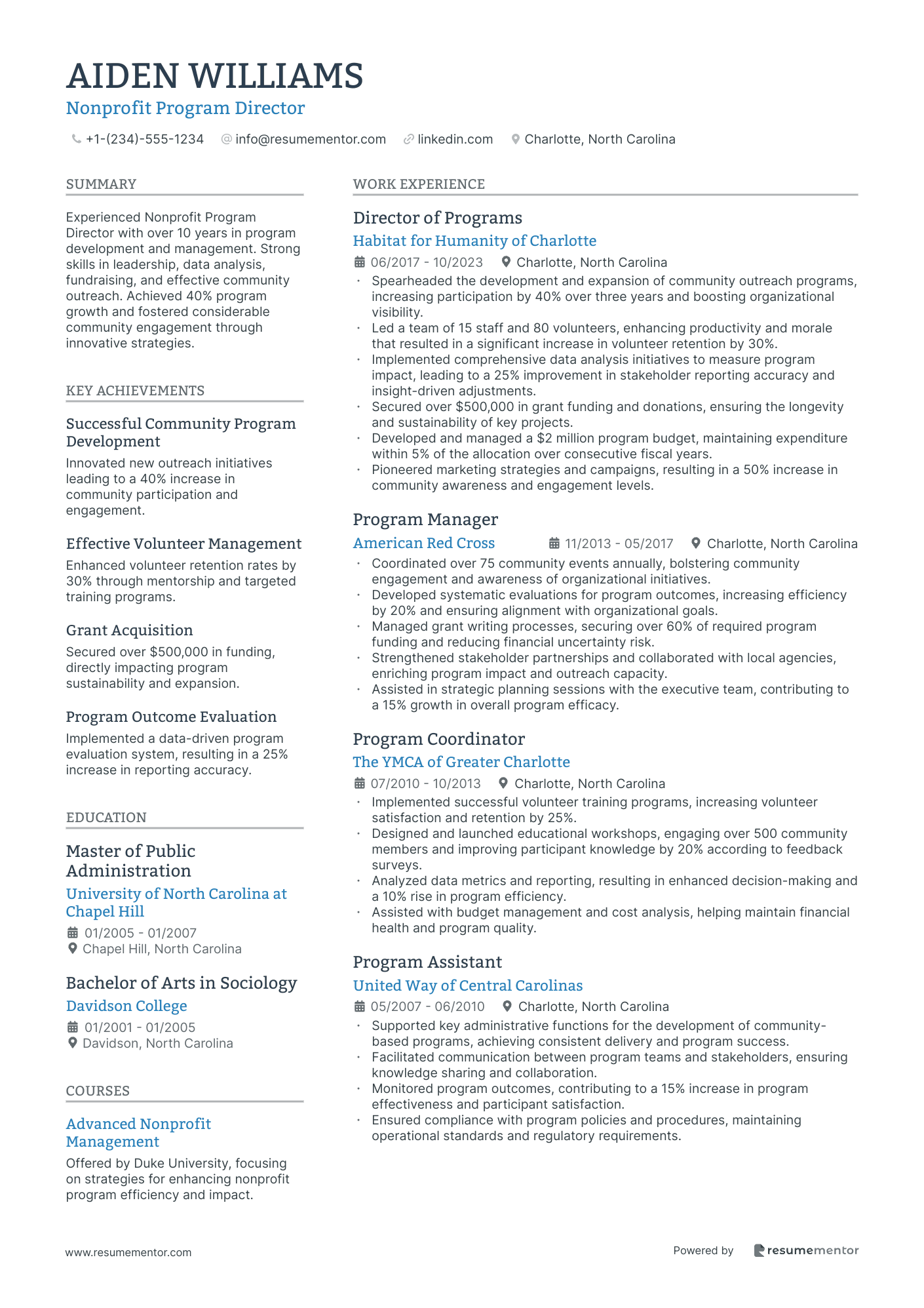
Nonprofit Program Director
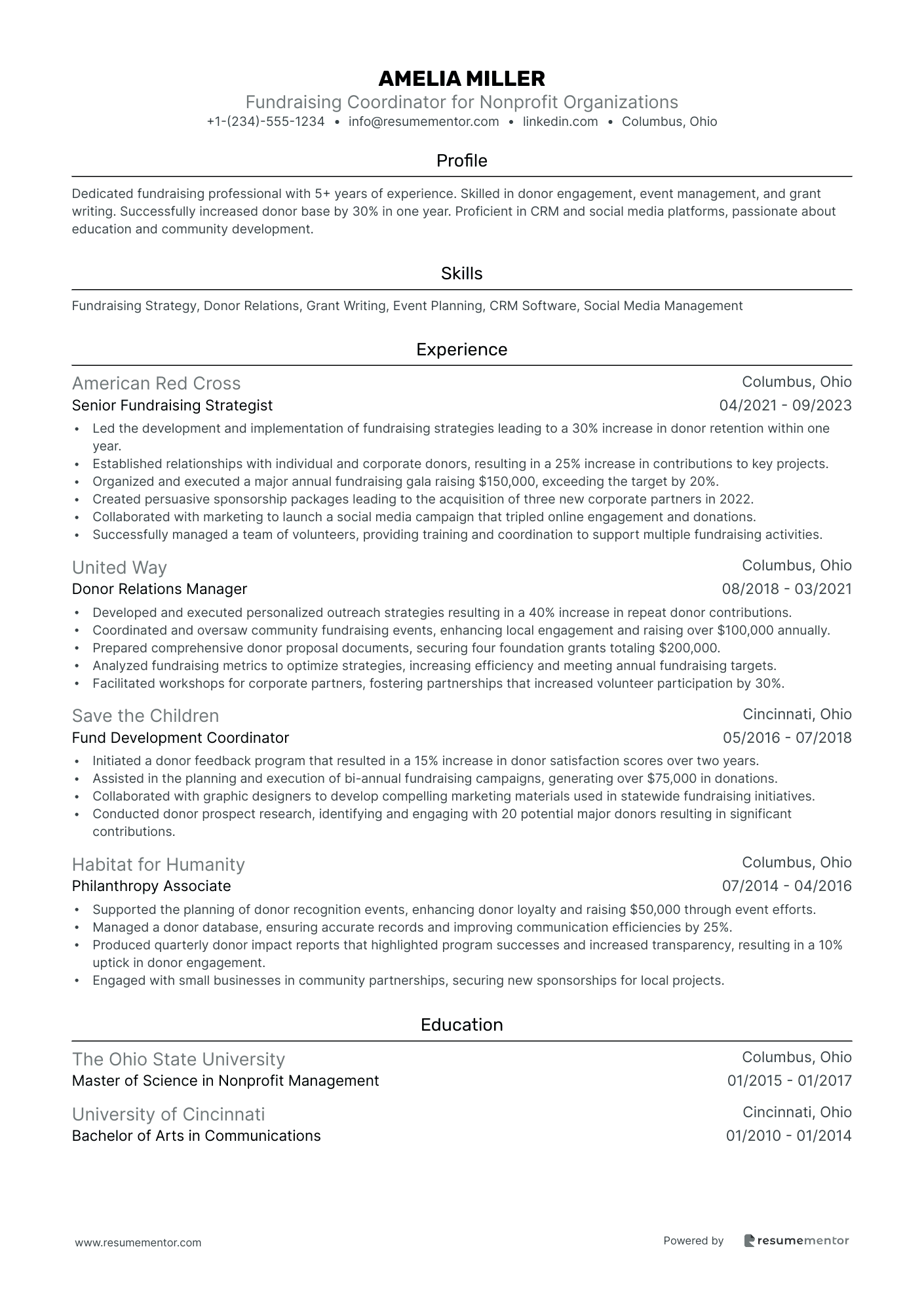
Fundraising Coordinator for Nonprofit Organizations
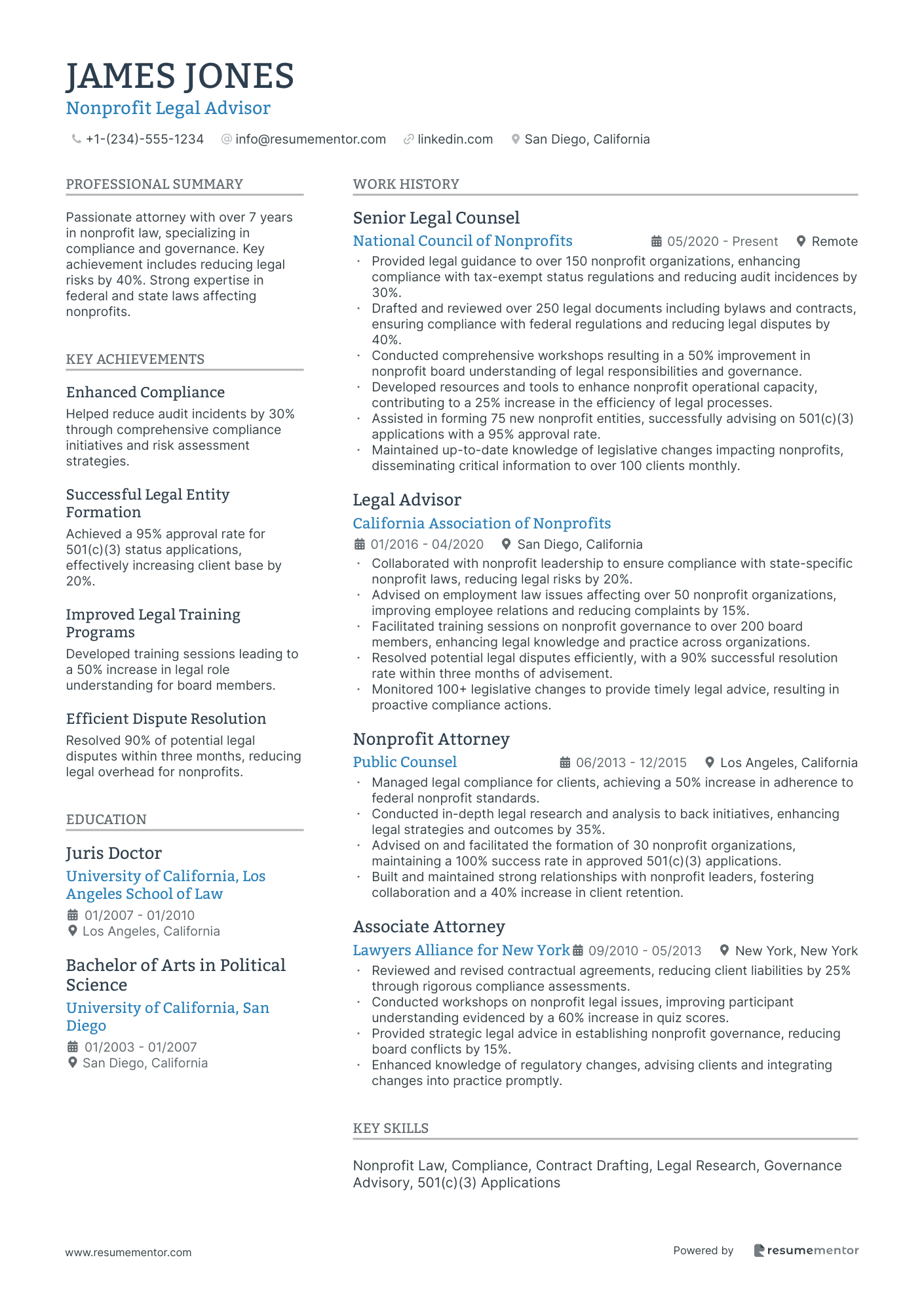
Nonprofit Legal Advisor
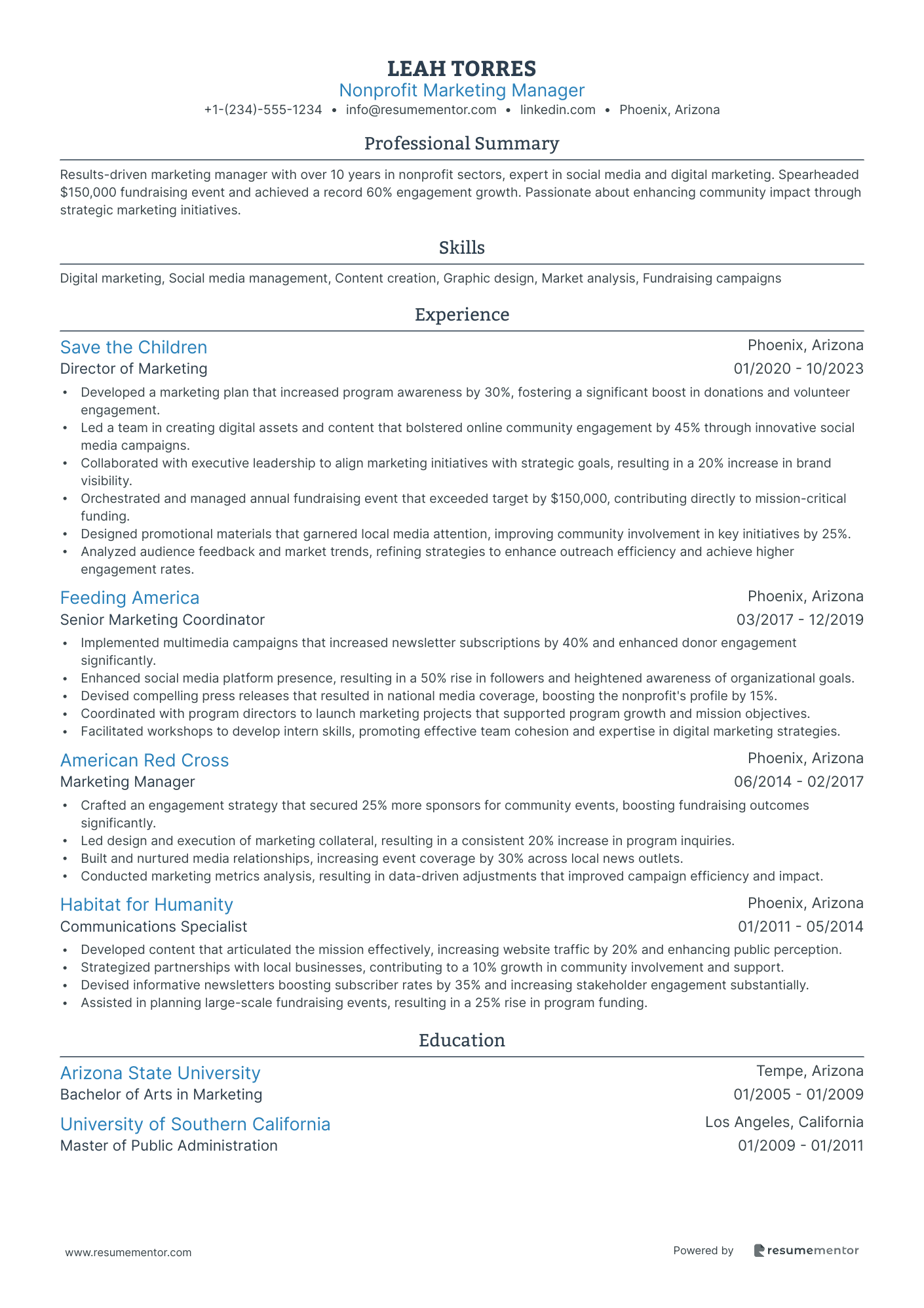
Nonprofit Marketing Manager
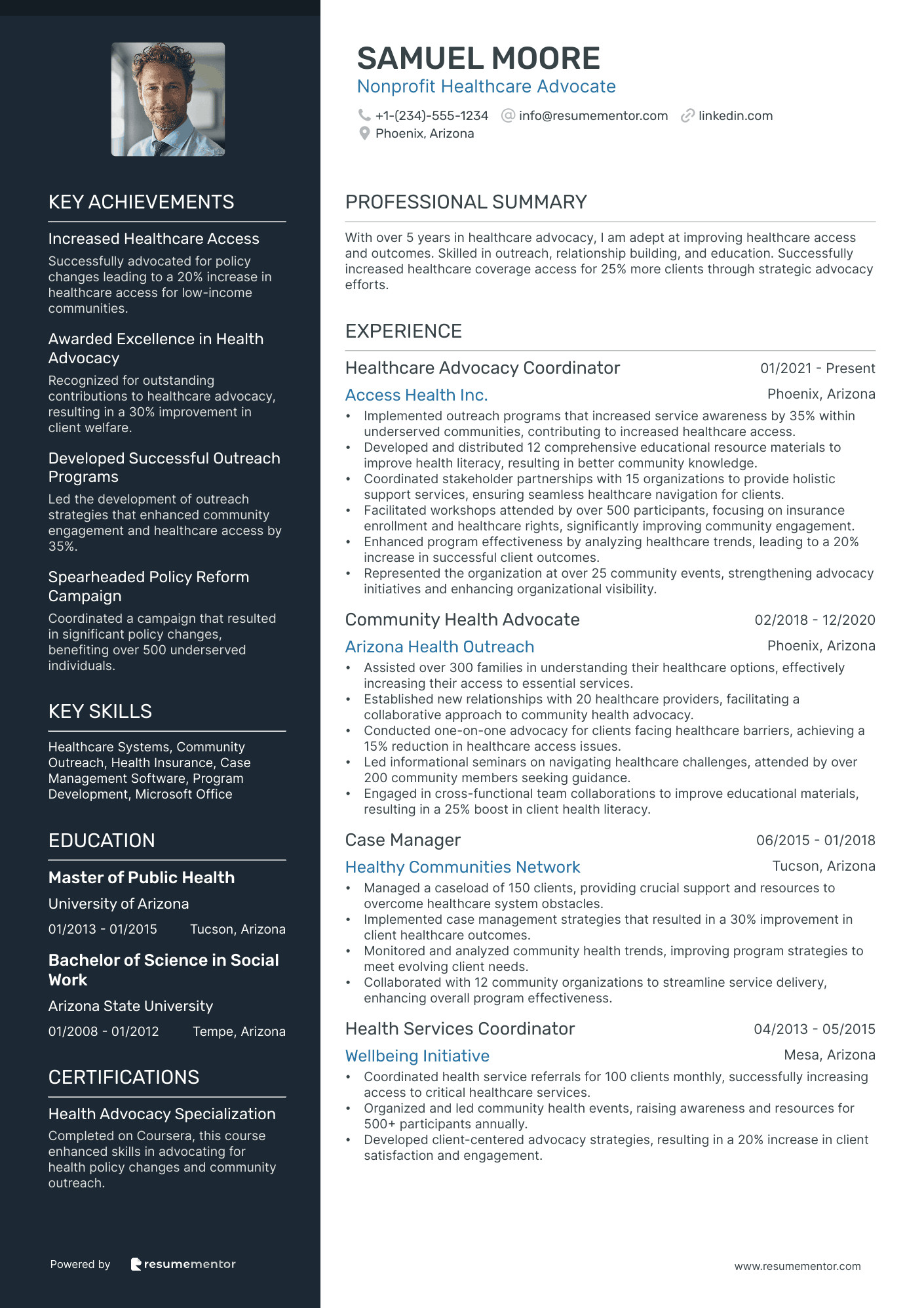
Nonprofit Healthcare Advocate
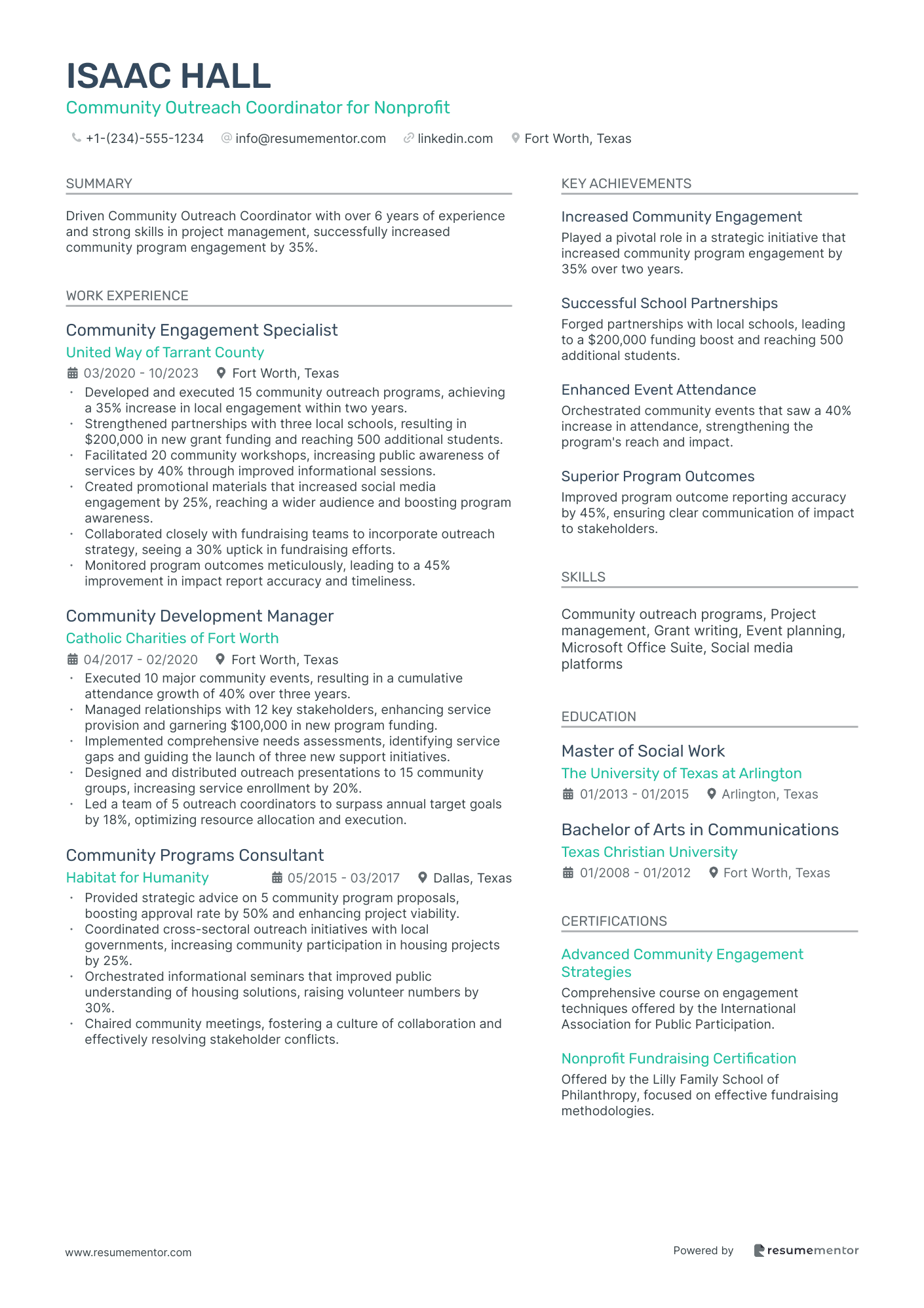
Community Outreach Coordinator for Nonprofit
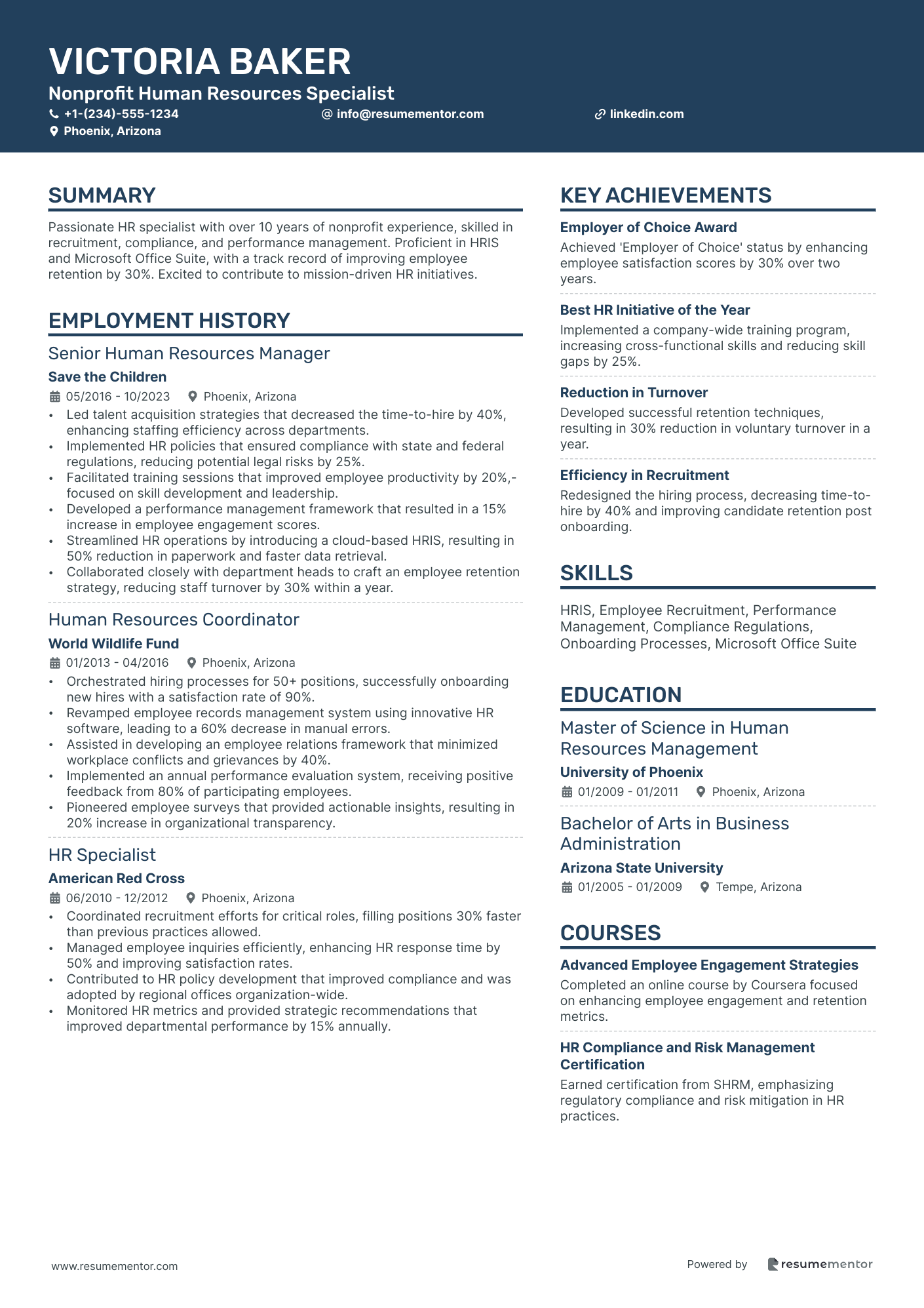
Nonprofit Human Resources Specialist
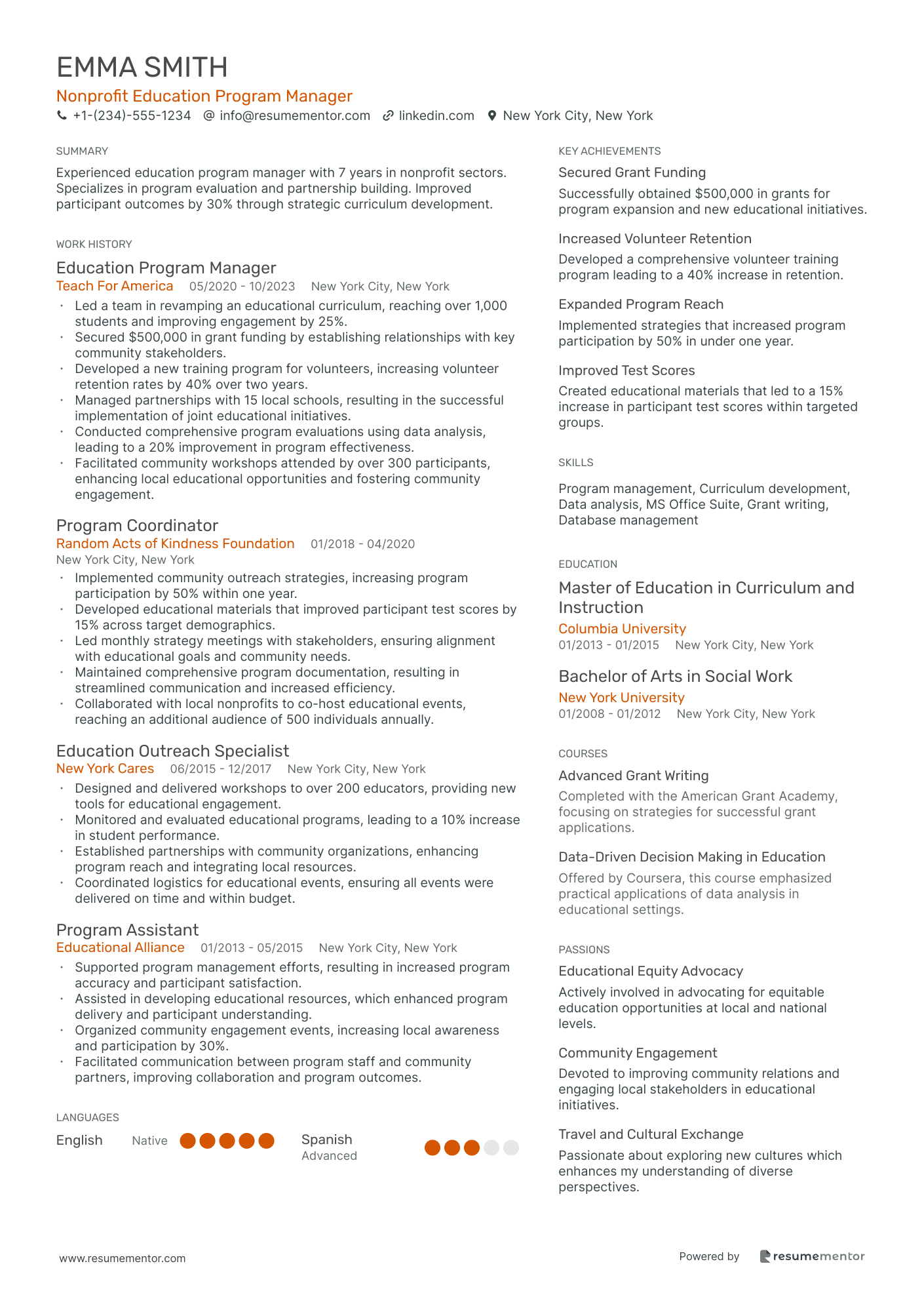
Nonprofit Education Program Manager

Financial Analyst for Nonprofit Organizations
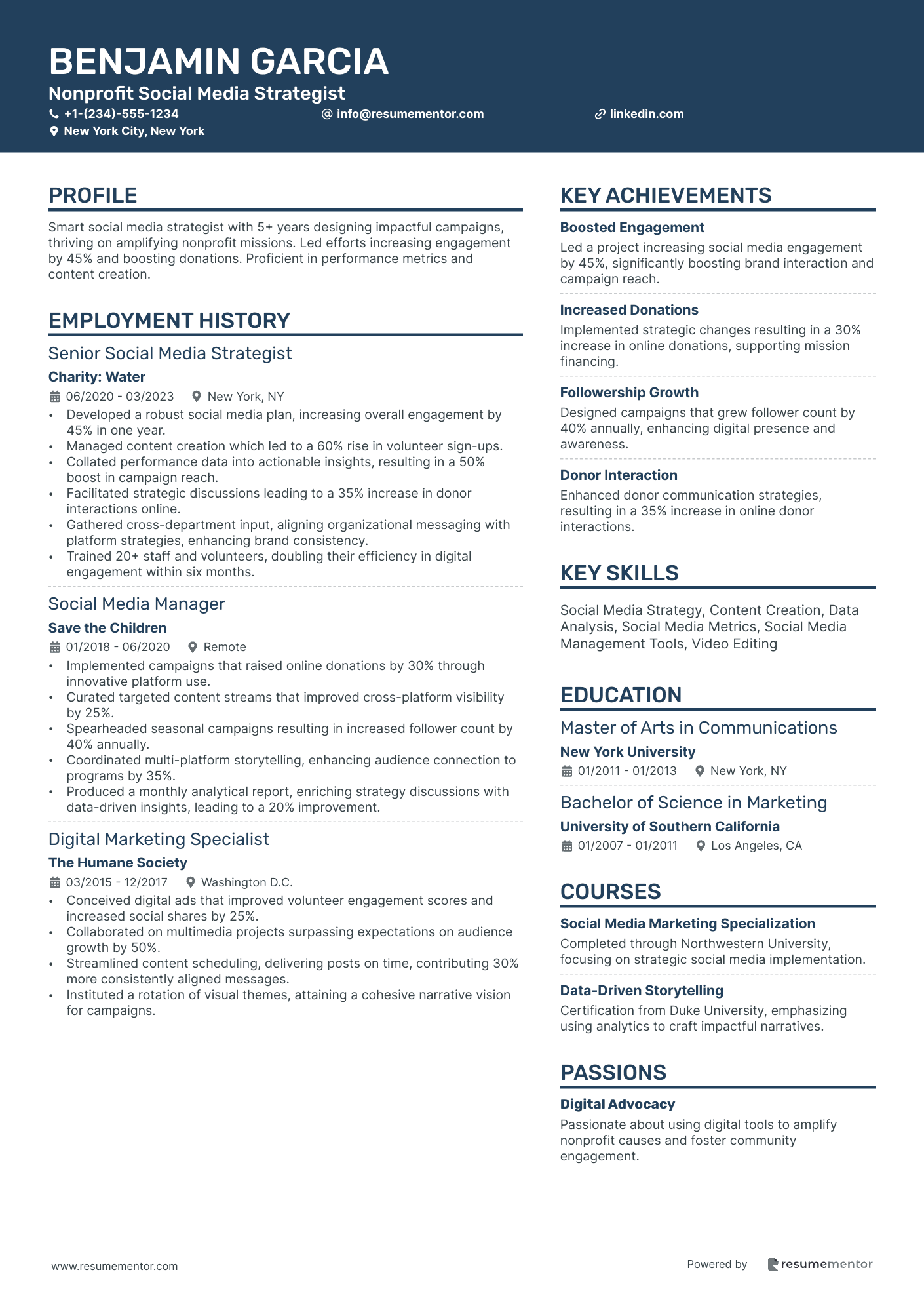
Nonprofit Social Media Strategist

Nonprofit Program Director resume sample
- •Spearheaded the development and expansion of community outreach programs, increasing participation by 40% over three years and boosting organizational visibility.
- •Led a team of 15 staff and 80 volunteers, enhancing productivity and morale that resulted in a significant increase in volunteer retention by 30%.
- •Implemented comprehensive data analysis initiatives to measure program impact, leading to a 25% improvement in stakeholder reporting accuracy and insight-driven adjustments.
- •Secured over $500,000 in grant funding and donations, ensuring the longevity and sustainability of key projects.
- •Developed and managed a $2 million program budget, maintaining expenditure within 5% of the allocation over consecutive fiscal years.
- •Pioneered marketing strategies and campaigns, resulting in a 50% increase in community awareness and engagement levels.
- •Coordinated over 75 community events annually, bolstering community engagement and awareness of organizational initiatives.
- •Developed systematic evaluations for program outcomes, increasing efficiency by 20% and ensuring alignment with organizational goals.
- •Managed grant writing processes, securing over 60% of required program funding and reducing financial uncertainty risk.
- •Strengthened stakeholder partnerships and collaborated with local agencies, enriching program impact and outreach capacity.
- •Assisted in strategic planning sessions with the executive team, contributing to a 15% growth in overall program efficacy.
- •Implemented successful volunteer training programs, increasing volunteer satisfaction and retention by 25%.
- •Designed and launched educational workshops, engaging over 500 community members and improving participant knowledge by 20% according to feedback surveys.
- •Analyzed data metrics and reporting, resulting in enhanced decision-making and a 10% rise in program efficiency.
- •Assisted with budget management and cost analysis, helping maintain financial health and program quality.
- •Supported key administrative functions for the development of community-based programs, achieving consistent delivery and program success.
- •Facilitated communication between program teams and stakeholders, ensuring knowledge sharing and collaboration.
- •Monitored program outcomes, contributing to a 15% increase in program effectiveness and participant satisfaction.
- •Ensured compliance with program policies and procedures, maintaining operational standards and regulatory requirements.
Fundraising Coordinator for Nonprofit Organizations resume sample
- •Led the development and implementation of fundraising strategies leading to a 30% increase in donor retention within one year.
- •Established relationships with individual and corporate donors, resulting in a 25% increase in contributions to key projects.
- •Organized and executed a major annual fundraising gala raising $150,000, exceeding the target by 20%.
- •Created persuasive sponsorship packages leading to the acquisition of three new corporate partners in 2022.
- •Collaborated with marketing to launch a social media campaign that tripled online engagement and donations.
- •Successfully managed a team of volunteers, providing training and coordination to support multiple fundraising activities.
- •Developed and executed personalized outreach strategies resulting in a 40% increase in repeat donor contributions.
- •Coordinated and oversaw community fundraising events, enhancing local engagement and raising over $100,000 annually.
- •Prepared comprehensive donor proposal documents, securing four foundation grants totaling $200,000.
- •Analyzed fundraising metrics to optimize strategies, increasing efficiency and meeting annual fundraising targets.
- •Facilitated workshops for corporate partners, fostering partnerships that increased volunteer participation by 30%.
- •Initiated a donor feedback program that resulted in a 15% increase in donor satisfaction scores over two years.
- •Assisted in the planning and execution of bi-annual fundraising campaigns, generating over $75,000 in donations.
- •Collaborated with graphic designers to develop compelling marketing materials used in statewide fundraising initiatives.
- •Conducted donor prospect research, identifying and engaging with 20 potential major donors resulting in significant contributions.
- •Supported the planning of donor recognition events, enhancing donor loyalty and raising $50,000 through event efforts.
- •Managed a donor database, ensuring accurate records and improving communication efficiencies by 25%.
- •Produced quarterly donor impact reports that highlighted program successes and increased transparency, resulting in a 10% uptick in donor engagement.
- •Engaged with small businesses in community partnerships, securing new sponsorships for local projects.
Nonprofit Legal Advisor resume sample
- •Provided legal guidance to over 150 nonprofit organizations, enhancing compliance with tax-exempt status regulations and reducing audit incidences by 30%.
- •Drafted and reviewed over 250 legal documents including bylaws and contracts, ensuring compliance with federal regulations and reducing legal disputes by 40%.
- •Conducted comprehensive workshops resulting in a 50% improvement in nonprofit board understanding of legal responsibilities and governance.
- •Developed resources and tools to enhance nonprofit operational capacity, contributing to a 25% increase in the efficiency of legal processes.
- •Assisted in forming 75 new nonprofit entities, successfully advising on 501(c)(3) applications with a 95% approval rate.
- •Maintained up-to-date knowledge of legislative changes impacting nonprofits, disseminating critical information to over 100 clients monthly.
- •Collaborated with nonprofit leadership to ensure compliance with state-specific nonprofit laws, reducing legal risks by 20%.
- •Advised on employment law issues affecting over 50 nonprofit organizations, improving employee relations and reducing complaints by 15%.
- •Facilitated training sessions on nonprofit governance to over 200 board members, enhancing legal knowledge and practice across organizations.
- •Resolved potential legal disputes efficiently, with a 90% successful resolution rate within three months of advisement.
- •Monitored 100+ legislative changes to provide timely legal advice, resulting in proactive compliance actions.
- •Managed legal compliance for clients, achieving a 50% increase in adherence to federal nonprofit standards.
- •Conducted in-depth legal research and analysis to back initiatives, enhancing legal strategies and outcomes by 35%.
- •Advised on and facilitated the formation of 30 nonprofit organizations, maintaining a 100% success rate in approved 501(c)(3) applications.
- •Built and maintained strong relationships with nonprofit leaders, fostering collaboration and a 40% increase in client retention.
- •Reviewed and revised contractual agreements, reducing client liabilities by 25% through rigorous compliance assessments.
- •Conducted workshops on nonprofit legal issues, improving participant understanding evidenced by a 60% increase in quiz scores.
- •Provided strategic legal advice in establishing nonprofit governance, reducing board conflicts by 15%.
- •Enhanced knowledge of regulatory changes, advising clients and integrating changes into practice promptly.
Nonprofit Marketing Manager resume sample
- •Developed a marketing plan that increased program awareness by 30%, fostering a significant boost in donations and volunteer engagement.
- •Led a team in creating digital assets and content that bolstered online community engagement by 45% through innovative social media campaigns.
- •Collaborated with executive leadership to align marketing initiatives with strategic goals, resulting in a 20% increase in brand visibility.
- •Orchestrated and managed annual fundraising event that exceeded target by $150,000, contributing directly to mission-critical funding.
- •Designed promotional materials that garnered local media attention, improving community involvement in key initiatives by 25%.
- •Analyzed audience feedback and market trends, refining strategies to enhance outreach efficiency and achieve higher engagement rates.
- •Implemented multimedia campaigns that increased newsletter subscriptions by 40% and enhanced donor engagement significantly.
- •Enhanced social media platform presence, resulting in a 50% rise in followers and heightened awareness of organizational goals.
- •Devised compelling press releases that resulted in national media coverage, boosting the nonprofit's profile by 15%.
- •Coordinated with program directors to launch marketing projects that supported program growth and mission objectives.
- •Facilitated workshops to develop intern skills, promoting effective team cohesion and expertise in digital marketing strategies.
- •Crafted an engagement strategy that secured 25% more sponsors for community events, boosting fundraising outcomes significantly.
- •Led design and execution of marketing collateral, resulting in a consistent 20% increase in program inquiries.
- •Built and nurtured media relationships, increasing event coverage by 30% across local news outlets.
- •Conducted marketing metrics analysis, resulting in data-driven adjustments that improved campaign efficiency and impact.
- •Developed content that articulated the mission effectively, increasing website traffic by 20% and enhancing public perception.
- •Strategized partnerships with local businesses, contributing to a 10% growth in community involvement and support.
- •Devised informative newsletters boosting subscriber rates by 35% and increasing stakeholder engagement substantially.
- •Assisted in planning large-scale fundraising events, resulting in a 25% rise in program funding.
Nonprofit Healthcare Advocate resume sample
- •Implemented outreach programs that increased service awareness by 35% within underserved communities, contributing to increased healthcare access.
- •Developed and distributed 12 comprehensive educational resource materials to improve health literacy, resulting in better community knowledge.
- •Coordinated stakeholder partnerships with 15 organizations to provide holistic support services, ensuring seamless healthcare navigation for clients.
- •Facilitated workshops attended by over 500 participants, focusing on insurance enrollment and healthcare rights, significantly improving community engagement.
- •Enhanced program effectiveness by analyzing healthcare trends, leading to a 20% increase in successful client outcomes.
- •Represented the organization at over 25 community events, strengthening advocacy initiatives and enhancing organizational visibility.
- •Assisted over 300 families in understanding their healthcare options, effectively increasing their access to essential services.
- •Established new relationships with 20 healthcare providers, facilitating a collaborative approach to community health advocacy.
- •Conducted one-on-one advocacy for clients facing healthcare barriers, achieving a 15% reduction in healthcare access issues.
- •Led informational seminars on navigating healthcare challenges, attended by over 200 community members seeking guidance.
- •Engaged in cross-functional team collaborations to improve educational materials, resulting in a 25% boost in client health literacy.
- •Managed a caseload of 150 clients, providing crucial support and resources to overcome healthcare system obstacles.
- •Implemented case management strategies that resulted in a 30% improvement in client healthcare outcomes.
- •Monitored and analyzed community health trends, improving program strategies to meet evolving client needs.
- •Collaborated with 12 community organizations to streamline service delivery, enhancing overall program effectiveness.
- •Coordinated health service referrals for 100 clients monthly, successfully increasing access to critical healthcare services.
- •Organized and led community health events, raising awareness and resources for 500+ participants annually.
- •Developed client-centered advocacy strategies, resulting in a 20% increase in client satisfaction and engagement.
Community Outreach Coordinator for Nonprofit resume sample
- •Developed and executed 15 community outreach programs, achieving a 35% increase in local engagement within two years.
- •Strengthened partnerships with three local schools, resulting in $200,000 in new grant funding and reaching 500 additional students.
- •Facilitated 20 community workshops, increasing public awareness of services by 40% through improved informational sessions.
- •Created promotional materials that increased social media engagement by 25%, reaching a wider audience and boosting program awareness.
- •Collaborated closely with fundraising teams to incorporate outreach strategy, seeing a 30% uptick in fundraising efforts.
- •Monitored program outcomes meticulously, leading to a 45% improvement in impact report accuracy and timeliness.
- •Executed 10 major community events, resulting in a cumulative attendance growth of 40% over three years.
- •Managed relationships with 12 key stakeholders, enhancing service provision and garnering $100,000 in new program funding.
- •Implemented comprehensive needs assessments, identifying service gaps and guiding the launch of three new support initiatives.
- •Designed and distributed outreach presentations to 15 community groups, increasing service enrollment by 20%.
- •Led a team of 5 outreach coordinators to surpass annual target goals by 18%, optimizing resource allocation and execution.
- •Provided strategic advice on 5 community program proposals, boosting approval rate by 50% and enhancing project viability.
- •Coordinated cross-sectoral outreach initiatives with local governments, increasing community participation in housing projects by 25%.
- •Orchestrated informational seminars that improved public understanding of housing solutions, raising volunteer numbers by 30%.
- •Chaired community meetings, fostering a culture of collaboration and effectively resolving stakeholder conflicts.
- •Launched an outreach campaign that successfully increased blood donation turnout by 50% in targeted communities.
- •Established strong relationships with local businesses, resulting in a 300% increase in partnership support.
- •Designed educational workshops that increased community disaster preparedness by 40% across two regions.
- •Assisted in developing grant proposals, contributing to a 60% increase in grant approval rates.
Nonprofit Human Resources Specialist resume sample
- •Led talent acquisition strategies that decreased the time-to-hire by 40%, enhancing staffing efficiency across departments.
- •Implemented HR policies that ensured compliance with state and federal regulations, reducing potential legal risks by 25%.
- •Facilitated training sessions that improved employee productivity by 20%,-focused on skill development and leadership.
- •Developed a performance management framework that resulted in a 15% increase in employee engagement scores.
- •Streamlined HR operations by introducing a cloud-based HRIS, resulting in 50% reduction in paperwork and faster data retrieval.
- •Collaborated closely with department heads to craft an employee retention strategy, reducing staff turnover by 30% within a year.
- •Orchestrated hiring processes for 50+ positions, successfully onboarding new hires with a satisfaction rate of 90%.
- •Revamped employee records management system using innovative HR software, leading to a 60% decrease in manual errors.
- •Assisted in developing an employee relations framework that minimized workplace conflicts and grievances by 40%.
- •Implemented an annual performance evaluation system, receiving positive feedback from 80% of participating employees.
- •Pioneered employee surveys that provided actionable insights, resulting in 20% increase in organizational transparency.
- •Coordinated recruitment efforts for critical roles, filling positions 30% faster than previous practices allowed.
- •Managed employee inquiries efficiently, enhancing HR response time by 50% and improving satisfaction rates.
- •Contributed to HR policy development that improved compliance and was adopted by regional offices organization-wide.
- •Monitored HR metrics and provided strategic recommendations that improved departmental performance by 15% annually.
- •Supported HR functions by maintaining accurate employee records, achieving 100% compliance in audits.
- •Assisted in onboarding processes that led to a 25% increase in new hire satisfaction ratings.
- •Helped implement a training program that increased employee job competency scores by 20% within three months.
- •Provided direct support in crafting and distributing HR communications, improving internal communication efficiency by 35%.
Nonprofit Education Program Manager resume sample
- •Led a team in revamping an educational curriculum, reaching over 1,000 students and improving engagement by 25%.
- •Secured $500,000 in grant funding by establishing relationships with key community stakeholders.
- •Developed a new training program for volunteers, increasing volunteer retention rates by 40% over two years.
- •Managed partnerships with 15 local schools, resulting in the successful implementation of joint educational initiatives.
- •Conducted comprehensive program evaluations using data analysis, leading to a 20% improvement in program effectiveness.
- •Facilitated community workshops attended by over 300 participants, enhancing local educational opportunities and fostering community engagement.
- •Implemented community outreach strategies, increasing program participation by 50% within one year.
- •Developed educational materials that improved participant test scores by 15% across target demographics.
- •Led monthly strategy meetings with stakeholders, ensuring alignment with educational goals and community needs.
- •Maintained comprehensive program documentation, resulting in streamlined communication and increased efficiency.
- •Collaborated with local nonprofits to co-host educational events, reaching an additional audience of 500 individuals annually.
- •Designed and delivered workshops to over 200 educators, providing new tools for educational engagement.
- •Monitored and evaluated educational programs, leading to a 10% increase in student performance.
- •Established partnerships with community organizations, enhancing program reach and integrating local resources.
- •Coordinated logistics for educational events, ensuring all events were delivered on time and within budget.
- •Supported program management efforts, resulting in increased program accuracy and participant satisfaction.
- •Assisted in developing educational resources, which enhanced program delivery and participant understanding.
- •Organized community engagement events, increasing local awareness and participation by 30%.
- •Facilitated communication between program staff and community partners, improving collaboration and program outcomes.
Financial Analyst for Nonprofit Organizations resume sample
- •Conducted comprehensive financial analysis for five nonprofit programs, increasing financial efficiency by 15% over two years.
- •Developed and managed program budgets totaling $5 million, aligning them with strategic goals and grant agreements.
- •Prepared monthly and quarterly financial statements, resulting in improved accuracy and reduced reporting errors by 30%.
- •Collaborated with cross-functional teams to optimize financial performance, leading to a $600,000 increase in funding.
- •Enhanced financial reporting processes, reducing budget review time by 40%, which facilitated faster decision-making.
- •Spearheaded financial modeling initiatives, assessing the impact of varying funding strategies on program sustainability.
- •Monitored and analyzed budgetary performance against objectives, enhancing the fiscal responsibility of nonprofit programs.
- •Prepared comprehensive budget forecasts with 95% accuracy, aiding in strategic financial planning efforts.
- •Streamlined financial reporting for stakeholders, achieving a 25% increase in reporting efficiency to donors and agencies.
- •Supported audits by preparing documentation, resulting in a 100% compliance score with federal regulations.
- •Delivered training sessions on nonprofit accounting principles, boosting team proficiency in financial analysis by 20%.
- •Contributed to the development of multimillion-dollar annual budgets, ensuring adherence to funding guidelines.
- •Analyzed financial discrepancies and proposed solutions, resulting in a 12% reduction in budget variances.
- •Prepared variance analyses, providing management with insights that supported effective fund allocation.
- •Coordinated with program managers to adjust budgets, increasing operational efficiency by 10% for arts initiatives.
- •Advised on financial strategies for fundraising campaigns, contributing to a 50% growth in donor contributions.
- •Implemented financial modeling techniques to project outcomes of various nonprofit funding scenarios.
- •Ensured compliance with GAAP, improving financial accuracy and lowering the margin for errors by 15%.
Nonprofit Social Media Strategist resume sample
- •Developed a robust social media plan, increasing overall engagement by 45% in one year.
- •Managed content creation which led to a 60% rise in volunteer sign-ups.
- •Collated performance data into actionable insights, resulting in a 50% boost in campaign reach.
- •Facilitated strategic discussions leading to a 35% increase in donor interactions online.
- •Gathered cross-department input, aligning organizational messaging with platform strategies, enhancing brand consistency.
- •Trained 20+ staff and volunteers, doubling their efficiency in digital engagement within six months.
- •Implemented campaigns that raised online donations by 30% through innovative platform use.
- •Curated targeted content streams that improved cross-platform visibility by 25%.
- •Spearheaded seasonal campaigns resulting in increased follower count by 40% annually.
- •Coordinated multi-platform storytelling, enhancing audience connection to programs by 35%.
- •Produced a monthly analytical report, enriching strategy discussions with data-driven insights, leading to a 20% improvement.
- •Conceived digital ads that improved volunteer engagement scores and increased social shares by 25%.
- •Collaborated on multimedia projects surpassing expectations on audience growth by 50%.
- •Streamlined content scheduling, delivering posts on time, contributing 30% more consistently aligned messages.
- •Instituted a rotation of visual themes, attaining a cohesive narrative vision for campaigns.
- •Enhanced platform-specific strategies boosting Twitter and Facebook engagement rates by 35%.
- •Instituted a community management system increasing response time by 40% and engagement by 20%.
- •Prepared social toolkits for various campaigns, increasing stakeholder involvement by 30%.
- •Executed real-time engagement tactics during events, doubling average interaction volume.
Crafting a nonprofit resume can feel like navigating a vast ocean without a compass. Your story is filled with purpose and passion, and capturing that on paper is essential for opening doors and creating opportunities. However, without the typical business jargon or quantifiable metrics, effectively conveying your impact can be challenging.
This is where a resume template becomes your guiding lighthouse, helping you organize your achievements clearly and compellingly. Explore these resume templates to lay a strong foundation for your nonprofit narrative. Nonprofit work requires a unique expertise, deeply rooted in community engagement and collaborative projects. Highlighting these skills effectively is crucial to standing out in the job market.
Navigating a job search means not only demonstrating your dedication to a cause but also showing how your unique talents can benefit a new team or mission. Translating your nonprofit experiences into terms that resonate with hiring managers can be tricky, but with clarity, focus, and the right tools, your resume can become a powerful testament to your impact and potential. As you delve into this guide, you'll discover ways to elevate your nonprofit experience, ensuring your values and achievements shine through in every line.
Key Takeaways
- Creating a nonprofit resume involves effectively communicating your passion, dedication, and expertise through clear and focused organization of achievements and experiences.
- Choosing the right resume format, using contemporary fonts, and ensuring consistent formatting (like saving as a PDF) helps maintain professionalism and readability for evaluators.
- Crafting succinct, action-focused experience sections with quantifiable results is crucial for demonstrating impact and aligning your past contributions with potential future roles.
- The skills section should include both hard skills like grant writing and budgeting, and soft skills like communication and leadership, tailoring them to fit the nonprofit environment.
- Extra sections, such as language proficiency, volunteer work, and hobbies, can enrich your resume by offering further insights into how your overall experiences align with the nonprofit's mission.
What to focus on when writing your nonprofit resume
A nonprofit resume should effectively communicate your passion, dedication, and expertise in the sector to the recruiter. Your resume should reflect your commitment to the cause and highlight skills and experiences that align with the nonprofit's mission, all while remaining clear and focused.
How to structure your nonprofit resume
- Contact Information: Start with your full name, phone number, email address, and LinkedIn profile. These details should be both current and professional to make a strong first impression—ensuring this information is accurate is crucial for facilitating communication and demonstrating your attention to detail, which can immediately set a positive tone for the rest of your resume.
- Objective or Summary: Share your career goals and the unique contributions you can bring to the nonprofit field. Tailor this section to demonstrate your passion for social change and how it aligns with the organization's values—this helps the hiring manager quickly see your intent and potential impact without sifting through your entire work history.
- Experience: Follow up with a list of your most recent jobs, highlighting roles that are especially relevant to the nonprofit sector. Emphasize achievements such as successful fundraising, volunteer coordination, or impactful community outreach; these showcase your capability to make a difference and your track record of success—showing quantifiable results can greatly enhance your credibility here.
- Skills: Complement your experience by emphasizing key skills important in nonprofit work, like grant writing, donor relations, advocacy, and program management. Including both soft skills and technical abilities ensures you cover what's crucial for success. Your ability to combine skills like communication and strategic planning will present you as a versatile candidate—demonstrating a balance of these skills further solidifies your fit for a dynamic nonprofit environment.
- Education: Round out your profile with your educational background, mentioning degrees, certifications, and relevant coursework. Additionally, note any workshops or seminars attended that deepen your expertise in the sector—education in relevant fields not only signifies your knowledge base but also your commitment to ongoing personal development.
- Volunteer Experience: Lastly, but certainly not least, include volunteer work that underscores your commitment to similar causes. This section is essential in painting a fuller picture of your dedication—by including impactful volunteer experiences, you not only show your commitment but also a consistent thread of engagement within the nonprofit sphere.
As we delve into each resume section more in-depth, attention to detail and strategic organization will play key roles in crafting an effective format.
Which resume format to choose
Selecting the right resume format for your nonprofit career is crucial to making a lasting impression. For a role-specific position, like a program manager or development officer, a chronological format is best if you have consistent experience. It allows potential employers to see your career progression in the nonprofit sector clearly. However, if you're switching from another industry or have varied experiences, a functional format can help emphasize your transferable skills and highlight achievements relevant to the new role.
When it comes to fonts, choosing Rubik, Lato, or Montserrat gives your resume a contemporary, professional look. These fonts ensure your resume is easy to read, which helps employers focus on your qualifications and accomplishments without distraction. It's a simple detail, but one that contributes to how polished your application appears.
Always save your resume as a PDF to ensure that formatting stays intact, regardless of the device used to view it. This consistency is especially important in nonprofit roles where multiple people might review your application. A PDF maintains your intended layout and ensures your resume looks the same to every reader.
Margins might seem trivial, but sticking to one-inch margins can make a significant difference. This spacing keeps your resume neat and allows room for notes if printed. An organized layout reflects your professionalism and attention to detail, qualities highly valued in the nonprofit sector where clarity and communication are key.
How to write a quantifiable resume experience section
A strong nonprofit resume experience section seamlessly highlights your impact and contributions, providing a tailored view of your professional journey. By starting with your most recent position and working backward, you create a clear narrative of your career path. It's best to focus on positions from the last ten to fifteen years unless earlier roles offer highly relevant experiences. By selecting job titles that align with your target roles, you underline the skills that are crucial in the nonprofit sector. Aligning your resume with the job ad involves using the employer’s language and showcasing the skills they prioritize. Action words like “led,” “developed,” “coordinated,” and “implemented” effectively communicate your initiative and impact.
- •Increased program reach by 45% in two years through strategic community partnerships.
- •Developed and secured funding for a new mentorship initiative, raising $150,000 in its first year.
- •Coordinated a team of 20 volunteers, leading to a 30% increase in program delivery efficiency.
- •Implemented an outcome measurement system that improved reporting accuracy by 50%.
This experience section clearly communicates your achievements by showcasing precise outcomes, a crucial element in demonstrating impact within the nonprofit sector. By emphasizing accomplishments such as boosting program reach and fundraising success, you effectively show employers how you've made a difference. Each bullet reflects key skills for nonprofits, using active language to highlight results and initiative.
This structure works because it is both concise and impactful, allowing hiring managers to swiftly grasp the value you bring. When you tailor this section to the job ad, you ensure that you align with what employers are seeking. This approach connects your past successes directly to your potential for future contributions, making your application both compelling and highly relevant.
Achievement-Focused resume experience section
An achievement-focused resume experience section should start with accomplishments that demonstrate your skills and align with the job you want. Identify where you've made a real impact and lead with that. Use action verbs to illustrate your contributions and aim to include quantifiable results that highlight your achievements. This approach not only makes your impact clear but also shows how you’ve supported the organization’s goals.
Keep the descriptions concise yet detailed, focusing on specific projects or improvements. Aim to include measurable changes that resulted from your actions. Tailor each experience to match the specific organization and role you are applying for, ensuring every detail is relevant. This strategic approach captures attention and clearly demonstrates the value you can bring to their team.
Volunteer Coordinator
Helping Hands Community Center
June 2021 - Present
- Increased volunteer retention rate by 25% through implementing a new engagement program.
- Created and managed a volunteer newsletter that boosted engagement by 40%.
- Coordinated a team of 50+ volunteers for a major fundraising event, raising $100,000.
- Developed training materials that improved volunteer preparedness and satisfaction.
Leadership-Focused resume experience section
A nonprofit leadership-focused resume experience section should clearly present your role in driving an organization towards its mission. Start by identifying your key leadership roles and the time committed to each, highlighting your capability to manage teams and lead initiatives to successful outcomes. To give a fuller picture, use numbers or data to illustrate how your leadership contributed to meeting the organization's goals, picking concrete examples like improvements in operations or increased revenue, participation, or engagement. It is essential to speak to achievements instead of tasks, as this places emphasis on your real-world impact.
Aim to show how your skills made a tangible difference by mentioning specific strategies or programs you developed and executed. This naturally shifts the spotlight to your strengths in collaboration, communication, and problem-solving, which enabled you to drive positive results even in challenging settings. Such a comprehensive approach allows hiring managers to clearly see your capability to lead, inspire change, and foster growth within a nonprofit environment.
Director of Community Engagement
Community Impact Nonprofit
January 2018 - Present
- Led a team of 15 volunteers to organize fundraising events, raising over $120,000 annually for community programs.
- Developed and implemented a strategic plan that increased organization membership by 40% in two years.
- Collaborated with local businesses to create partnerships, enhancing resource sharing and program reach.
- Mentored junior staff, increasing their engagement and advancing their professional growth within the organization.
Skills-Focused resume experience section
A skills-focused nonprofit resume experience section should highlight the key abilities that align with the job you're targeting, such as fundraising, community outreach, or program management. Begin by identifying these critical skills and then describe how your previous roles have helped develop them. Support your narrative with concrete examples and measurable outcomes. Using active language will help you clearly demonstrate your achievements and the positive impacts you've made on your organizations.
After pinpointing your key skills, present your experience in a structured way that emphasizes your fit for the role. Highlight relevant positions and focus on how they connect to the job you want. Organize your accomplishments with bullet points to ensure clarity and ease of reading. The goal is to show how your past experiences and skills align with the nonprofit’s mission, showcasing that you are well-equipped to contribute effectively.
Community Outreach Coordinator
Local Nonprofit Organization
June 2018 - August 2022
- Organized and led over 20 community events that boosted local participation, resulting in a 30% increase in volunteer involvement.
- Built partnerships with local businesses, securing $50,000 in donations to fund community programs.
- Managed a team of 15 volunteers, providing training and support to achieve project goals efficiently.
- Coordinated a successful social media campaign that increased online engagement by 40%.
Responsibility-Focused resume experience section
A Responsibility-Focused nonprofit resume experience section should demonstrate how your diligent efforts contributed significantly to the organization's goals. Begin by highlighting roles where you took charge of projects, led teams, or initiated impactful changes that supported the nonprofit's mission. It's important to show the tangible effects of your work—whether through increased funds, communities served, or enhanced efficiencies. Tailor each entry to reflect your dedication to furthering the nonprofit’s objectives and how your actions made a meaningful difference.
When writing, use clear language to effectively communicate your accomplishments, starting with dynamic action words that display leadership or initiative. Offer specific examples of your work, supported by numbers that show solid results. Describe your role and how you met your responsibilities in a smooth narrative without repetition. Make sure each bullet connects with the broader picture of how you manage and accomplish tasks successfully in a nonprofit setting.
Volunteer Coordinator
Community Action Network
June 2019 - August 2021
- Coordinated a team of over 50 volunteers for community events, boosting participation rates by 30%.
- Developed training programs that improved volunteer engagement, helping to increase retention by 15%.
- Created a new system for scheduling shifts, which cut down on conflicts by 40%.
- Partnered with local groups to expand our outreach efforts, raising community awareness by 25%.
Write your nonprofit resume summary section
A nonprofit-focused resume summary should spotlight what makes you stand out. Think of it as a brief story at the top of your resume that connects your skills, experiences, and dedication to the nonprofit world. This opening should engage recruiters and make them eager to learn more about you. When crafting your summary, emphasize your passion for the cause, highlight specific achievements, and outline essential skills. Consider this example:
This summary not only communicates the candidate's experiences and accomplishments but also their commitment to the nonprofit sector. By including metrics like a "30% increase in yearly contributions," it provides measurable success. When describing yourself, use dynamic language and focus on specific accomplishments. Terms like “dedicated,” “proven,” and “passionate” convey strong characteristics.
It's important to differentiate between a resume summary and a resume objective. A summary highlights past accomplishments and the skills you currently offer, while an objective sets forth your aspirations with the organization. A resume profile goes deeper with detailed background insights, whereas a summary of qualifications presents your key skills in a concise format, often with bullet points. Use a summary if you're seasoned in the field, or opt for an objective if you're just starting out. Both approaches should be targeted, demonstrating why you’re the ideal candidate for the role.
Listing your nonprofit skills on your resume
A nonprofit-focused resume should make your skills shine, whether in a standalone section or woven into your experience and summary. Highlighting strengths and soft skills, like teamwork and communication, is essential. These interpersonal qualities help nonprofit organizations work effectively towards their mission. On the other hand, hard skills refer to teachable abilities; for instance, grant writing and program evaluation are valuable in the nonprofit sector. Such skills aren't just attributes; they function as keywords, boosting the visibility of your resume to hiring managers and digital systems.
Here's a well-crafted example of a standalone skills section that showcases important competencies for the nonprofit world:
This section is strong because it focuses on skills nonprofits frequently need, showing your preparedness for essential tasks.
Best hard skills to feature on your nonprofit resume
Featured hard skills should demonstrate your ability to manage tasks crucial to nonprofit operations. These technical and specialized skills show you're equipped to contribute effectively.
Hard Skills
- Grant Writing
- Financial Management
- Program Development
- Project Management
- Marketing Strategy
- Database Management
- Data Analysis
- Event Planning
- Research Skills
- Public Relations
- Compliance and Regulation
- Strategic Planning
- Technology Proficiency
- Policy Analysis
- Multilingual Competency
Best soft skills to feature on your nonprofit resume
Include soft skills that show your ability to collaborate and lead in a nonprofit setting. These traits highlight your capability to excel in a mission-driven, team-focused environment.
Soft Skills
- Communication
- Empathy
- Teamwork
- Leadership
- Problem-Solving
- Adaptability
- Conflict Resolution
- Creativity
- Time Management
- Networking
- Emotional Intelligence
- Negotiation
- Decision-Making
- Patience
- Active Listening
How to include your education on your resume
An education section is a crucial part of your nonprofit resume. Tailoring this section to fit the job you're aiming for is important. List only relevant education to keep your resume focused and clear. Including GPA is optional but can be advantageous if it's strong; just list it beside your degree if you do. Mention any honors like cum laude to highlight your academic achievements. When listing a degree, make sure to state the degree type, institution, and graduation date.
Wrong example:
Right example:
The right example is well-suited for a nonprofit position by showcasing a related degree, Social Work, from a reputable institution. The cum laude mention illustrates academic excellence, appealing to potential employers. A GPA of 3.8 highlights strong academic performance. The degree is clearly stated, making it easy for hiring managers to grasp your qualifications quickly.
How to include nonprofit certificates on your resume
Including a certificates section in your nonprofit resume is crucial. List the name and title of each certificate you have earned. Include the date you received the certificate to provide context. Add the issuing organization to emphasize the credibility. Certificates significantly boost your candidacy by highlighting specialized skills and continuing education. Be sure to tailor the certificates to relevance, aligning them closely with the job you're applying for. Certificates can also be included in the header of your resume, directly under your name. For example, "Jane Doe, Nonprofit Fundraising Expert | Certified Nonprofit Professional." This approach ensures key certifications are immediately visible to employers.
Here's an example of a well-crafted certificate section:
This example is effective because the certificates directly support a career in nonprofit work. The title "Certified Nonprofit Professional" is relevant to the job, showing specialized knowledge in the nonprofit sector. The issuer, "Nonprofit Leadership Alliance," is a respected organization, adding credibility. Including this section helps demonstrate your commitment to professional development and your qualifications for the role.
Extra sections to include on your nonprofit resume
Crafting a compelling nonprofit resume requires you to showcase your skills, experiences, and passions. These elements collectively paint a picture of your personal and professional journey, highlighting what makes you a valuable asset to the organization you're hoping to join. Including different sections in your resume can provide potential employers with a deeper understanding of who you are beyond work experience.
Language section — Highlight any languages you speak to demonstrate your ability to connect with diverse communities and international partners.
Hobbies and interests section — Mention hobbies and interests to show your personal passions and how they align with the mission of the nonprofit.
Volunteer work section — Include volunteer experiences to emphasize your commitment to community service and social causes.
Books section — List meaningful books to highlight your interests in subjects relevant to the sector and your dedication to continued learning.
Including these sections in your resume can enrich your professional story, making you more relatable and well-rounded. Their presence shows how your personal and professional experiences meet the needs of the nonprofit world.
In Conclusion
In conclusion, creating a strong nonprofit resume can seem challenging, but a strategic approach can lead you to success. A resume acts as the bridge between your past experiences and future contributions to an organization. Focus on showcasing your passion for social change and the specific skills you bring to the table. Using a clear structure, highlight your achievements with quantifiable results that speak volumes about your capabilities. Be sure to tailor your resume to the specific job, using language that resonates with potential employers.
Choosing the right resume format and fonts can also make all the difference, ensuring your document is both engaging and professional. Additionally, don’t forget to include any relevant certifications, as they enhance your credibility and demonstrate your commitment to the field. The sections of your resume should not only reflect your professional experiences but also give insight into your personal values and interests.
Whether it's through listing your volunteer work, your educational background, or your hobbies, these elements can connect to the nonprofit mission and highlight your fit for the role. Remember, every part of your resume should serve a purpose and build a compelling narrative of who you are. Armed with these insights and tools, you're well-prepared to craft a resume that not only opens doors but also creates genuine opportunities in the nonprofit sector.
Related Articles
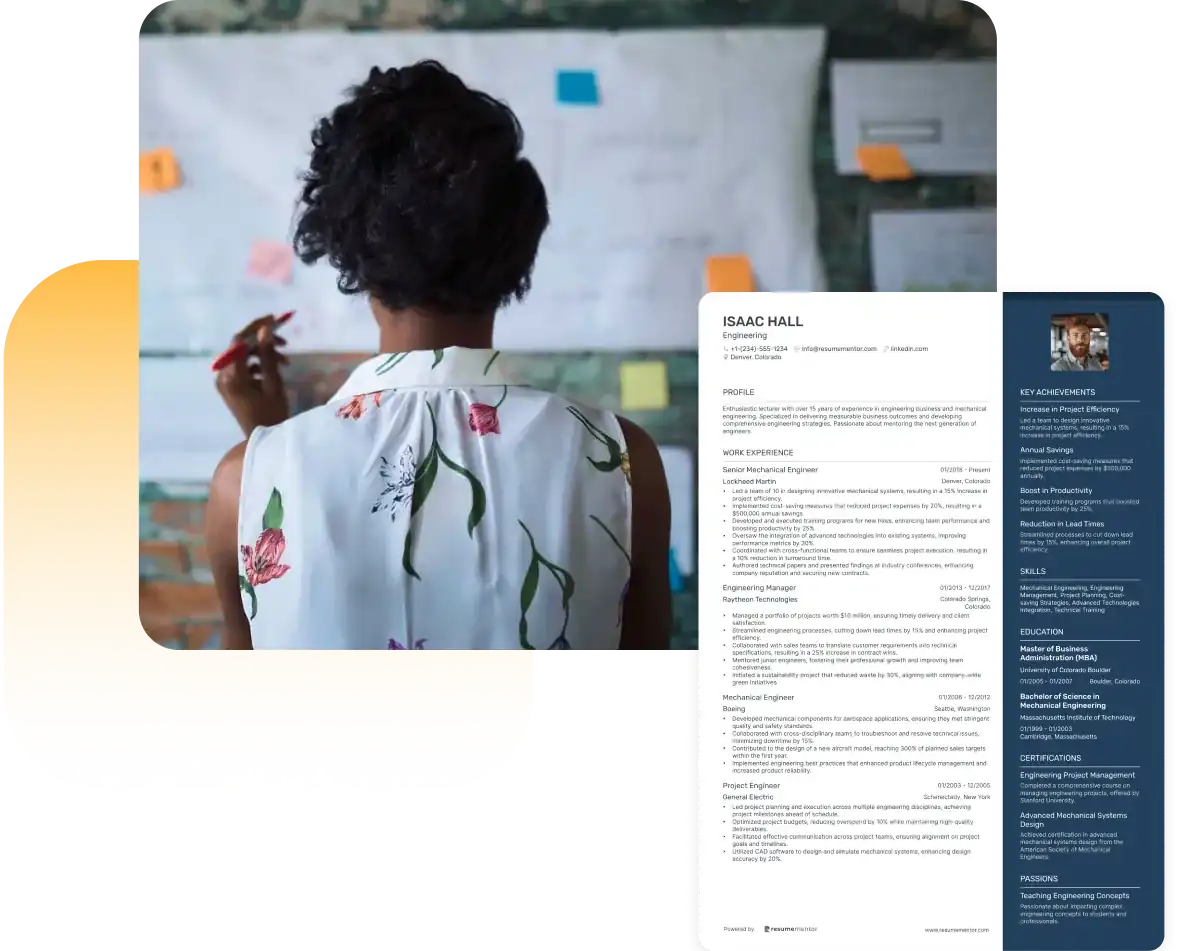
Continue Reading
Check more recommended readings to get the job of your dreams.
Resume
Resources
Tools
© 2025. All rights reserved.
Made with love by people who care.

